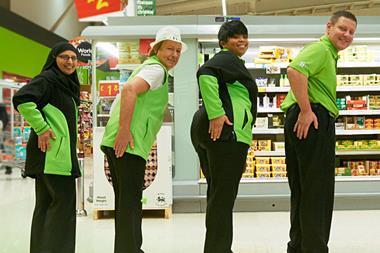Tesco's much awaited instore digital advertising trial, Tesco TV, kicks off this month. Its main aim is to test customer acceptance of brand advertising on screens dotted around the store. Two more stores come on stream next month and, if successful, there will be national roll out from July, with 300 stores by the end of next year.
The major challenge for Tesco, and other retailers wishing to become mass-market media owners, though, is not to convince the customer, it is to persuade the people who buy media space that the retail channel should be integrated into the advertising mix. That is more difficult than it sounds.
The problem is quite simple: retailers and media planners talk totally different languages. In retail it is "transactions" and "sales uplifts", in agencies it is "cover" (the percentage of the population that will see the campaign), "frequency" (the number of times they see it) and "cost per thousand".
The solution: to have a measurement system that enables media buyers to forward plan, easily compare the different media, assess return on investment, and thus allocate their client's ad spend most appropriately.
"We need to use the traditional media currency of cover and frequency. That way we can demonstrate the long-term branding benefits of supermarket advertising," explains Ann Jonas, marketing director at poster panel operator Maiden Outdoor". It is about moving from transaction numbers to audience for each store."
Food retailers, of course, argue that theirs is the most accountable media channel. After all they can evaluate loyalty card and EPoS data to directly measure a campaign's impact and build a customer profile.
Bob Clarke, chief executive of Instrument, which is managing the Tesco trial, says: "Retailers and brand owners are very comfortable with the notion that captive audience networks (like Tesco TV) are a unique hybrid of TV brand advertising and point of sale in that they have a demonstrable ability to impact on sales in the store in real time. It is arguably over-simplistic to do a direct comparison with how TV advertising is bought and measured, because the content formats can be so different."
Getting this argument over will be easier when networks are linked into EPoS to enable sales uplift to be tracked against different broadcast patterns, says Clarke. Then, "there will be nothing else as dynamic in terms of a medium's ability to directly and measurably influence consumer spending".
However, he concedes: "Until that happens we need to find enlightened media agencies willing to break the old mould in the name of progress."
Maiden thinks media planners will only be comfortable when they can plan and purchase as they do for traditional media.
A fortnight ago, Maiden launched the first cover and frequency measurement system for its six-sheet poster panels at supermarkets. It has taken two years to develop and works by taking the number of transactions and multiplying them by the number of shoppers at each transaction to find the number of shopper visits.
This number is then divided by the frequency of visit by different types of shopper to get the number of individual shoppers per store, using TNS Superpanel data.
Census data and gravity density models are used to find the shoppers' profiles. Duplication of shoppers at each store in a given area is factored out and poster visibility model Blade Grading System is used to take the store level cover down to individual panel level.
The front-end software enables agencies and clients to view geography, panel attributes, store attributes and demographics. They can drill down into individual TV areas, location of panels, panel type, store size, age group and social class among others. Thus, they can buy into individual store groups, packages across demographics or tie in with a TV campaign in a specific region. The system will tell them availability during their desired period and the cost.
"It can be filtered many ways. For example, a brand owner could put in "Asda", in "Yorkshire" and the "north-east", and just "car park panels" and discover what is available at the time," said Jonas.
For the poster industry it is important to change media planners' perceptions. They regard posters as passive consumption. But at least posters are an accepted advertising medium. For those involved in the brave new world of instore digital communication the challenge is even greater.
In a study carried out by RMS on behalf of Point of Purchase Advertising International (see charts above), a third of respondents thought it would take three years for this medium to become an established part of the marketing repertoire.
More importantly, it was not just media agencies that needed convincing. The research showed that, while brand manufacturers believed digital instore communication would play an increasingly important role in the future, many did not understand the medium.
"Retailers have got involved quickly but the brands, the people expected to dip into their pockets to justify investment in the medium, have very little knowledge," says POPAI general manager Martin Kingdon.
He believes the industry needs proven business models to help retailers and brand owners make informed decisions.
Steve Tindall, managing partner at WPP-owned Mindshare, agrees research is essential. "Clients are asking for an increased level of accountability. We need figures if we are to generate greater confidence in what they are getting from their pound."
But, while sounding a note of caution, Tindall believes there is a future for this channel. "Retailers and brands who do not harness this new world of captive audience networks may risk losing this golden goose. And agencies will lose out unless they understand the contribution of all routes to market."
The good news for instore networks is that, although 40% of respondents to the POPAI study had no involvement in them at the moment, 85% believed their involvement would increase.
The bad news is much more research and evaluation are needed if retailers are to persuade brand owners and their media planners that this is a new media channel and not just an extension or replacement for traditional trade marketing expenditure.
Mass media channels have recognised audience measurements, for example BARB for TV and RAJAR for radio. Retailers, their media sales agencies and providers of any instore advertising networks need to work towards developing the same if they are to be seen as a true media channel.
{{ANALYSIS }}
The major challenge for Tesco, and other retailers wishing to become mass-market media owners, though, is not to convince the customer, it is to persuade the people who buy media space that the retail channel should be integrated into the advertising mix. That is more difficult than it sounds.
The problem is quite simple: retailers and media planners talk totally different languages. In retail it is "transactions" and "sales uplifts", in agencies it is "cover" (the percentage of the population that will see the campaign), "frequency" (the number of times they see it) and "cost per thousand".
The solution: to have a measurement system that enables media buyers to forward plan, easily compare the different media, assess return on investment, and thus allocate their client's ad spend most appropriately.
"We need to use the traditional media currency of cover and frequency. That way we can demonstrate the long-term branding benefits of supermarket advertising," explains Ann Jonas, marketing director at poster panel operator Maiden Outdoor". It is about moving from transaction numbers to audience for each store."
Food retailers, of course, argue that theirs is the most accountable media channel. After all they can evaluate loyalty card and EPoS data to directly measure a campaign's impact and build a customer profile.
Bob Clarke, chief executive of Instrument, which is managing the Tesco trial, says: "Retailers and brand owners are very comfortable with the notion that captive audience networks (like Tesco TV) are a unique hybrid of TV brand advertising and point of sale in that they have a demonstrable ability to impact on sales in the store in real time. It is arguably over-simplistic to do a direct comparison with how TV advertising is bought and measured, because the content formats can be so different."
Getting this argument over will be easier when networks are linked into EPoS to enable sales uplift to be tracked against different broadcast patterns, says Clarke. Then, "there will be nothing else as dynamic in terms of a medium's ability to directly and measurably influence consumer spending".
However, he concedes: "Until that happens we need to find enlightened media agencies willing to break the old mould in the name of progress."
Maiden thinks media planners will only be comfortable when they can plan and purchase as they do for traditional media.
A fortnight ago, Maiden launched the first cover and frequency measurement system for its six-sheet poster panels at supermarkets. It has taken two years to develop and works by taking the number of transactions and multiplying them by the number of shoppers at each transaction to find the number of shopper visits.
This number is then divided by the frequency of visit by different types of shopper to get the number of individual shoppers per store, using TNS Superpanel data.
Census data and gravity density models are used to find the shoppers' profiles. Duplication of shoppers at each store in a given area is factored out and poster visibility model Blade Grading System is used to take the store level cover down to individual panel level.
The front-end software enables agencies and clients to view geography, panel attributes, store attributes and demographics. They can drill down into individual TV areas, location of panels, panel type, store size, age group and social class among others. Thus, they can buy into individual store groups, packages across demographics or tie in with a TV campaign in a specific region. The system will tell them availability during their desired period and the cost.
"It can be filtered many ways. For example, a brand owner could put in "Asda", in "Yorkshire" and the "north-east", and just "car park panels" and discover what is available at the time," said Jonas.
For the poster industry it is important to change media planners' perceptions. They regard posters as passive consumption. But at least posters are an accepted advertising medium. For those involved in the brave new world of instore digital communication the challenge is even greater.
In a study carried out by RMS on behalf of Point of Purchase Advertising International (see charts above), a third of respondents thought it would take three years for this medium to become an established part of the marketing repertoire.
More importantly, it was not just media agencies that needed convincing. The research showed that, while brand manufacturers believed digital instore communication would play an increasingly important role in the future, many did not understand the medium.
"Retailers have got involved quickly but the brands, the people expected to dip into their pockets to justify investment in the medium, have very little knowledge," says POPAI general manager Martin Kingdon.
He believes the industry needs proven business models to help retailers and brand owners make informed decisions.
Steve Tindall, managing partner at WPP-owned Mindshare, agrees research is essential. "Clients are asking for an increased level of accountability. We need figures if we are to generate greater confidence in what they are getting from their pound."
But, while sounding a note of caution, Tindall believes there is a future for this channel. "Retailers and brands who do not harness this new world of captive audience networks may risk losing this golden goose. And agencies will lose out unless they understand the contribution of all routes to market."
The good news for instore networks is that, although 40% of respondents to the POPAI study had no involvement in them at the moment, 85% believed their involvement would increase.
The bad news is much more research and evaluation are needed if retailers are to persuade brand owners and their media planners that this is a new media channel and not just an extension or replacement for traditional trade marketing expenditure.
Mass media channels have recognised audience measurements, for example BARB for TV and RAJAR for radio. Retailers, their media sales agencies and providers of any instore advertising networks need to work towards developing the same if they are to be seen as a true media channel.
{{ANALYSIS }}















No comments yet